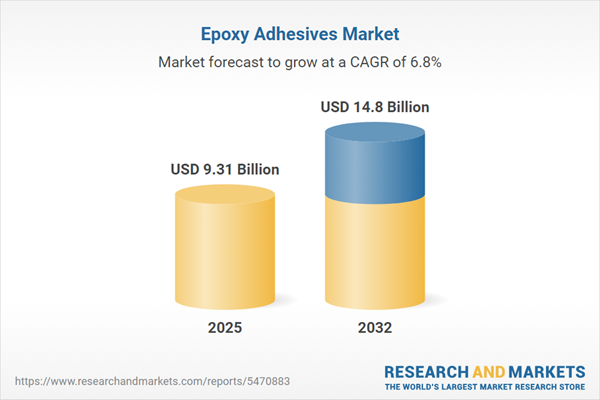Speak directly to the analyst to clarify any post sales queries you may have.
The global epoxy adhesives market is undergoing significant transformation, shaped by technical innovation, shifting regulations, and evolving industry demands. Senior executives and stakeholders require strategic insights to navigate these changes efficiently and secure future growth.
Market Snapshot: Growth and Strategic Trends in the Epoxy Adhesives Market
The Epoxy Adhesives Market grew from USD 8.72 billion in 2024 to USD 9.31 billion in 2025. It is projected to continue its momentum with a CAGR of 6.82%, reaching USD 14.80 billion by 2032. This trajectory reflects growing adoption in sectors such as construction, electronics, transportation, and advanced manufacturing. The market benefits from ongoing innovation in resin chemistry and curing technologies, which enhance product efficiency and expand usable applications. As new regulatory requirements and global sustainability initiatives gain importance, the competitive landscape is adapting rapidly.
Scope & Segmentation: Market Coverage and Key Regional Dynamics
- End Use Industry: Markets served include construction, electronics and electrical equipment, oil & gas, sports and leisure, transportation (aerospace & defense, automotive, marine), and wind energy.
- Application: Key areas encompass adhesives, coatings, composites, electrical insulation, potting & encapsulation, repair & maintenance, and sealants.
- Resin Type: The industry leverages Bisphenol A, cycloaliphatic, glycidyl ethers, and novolac variations to deliver tailored performance attributes for diverse uses.
- Technology: Solutions offered include both one-component and two-component systems for flexible application options and unique curing requirements.
- Form: Epoxy adhesives are available in liquid, paste, and powder forms, supporting a variety of processing methods and application environments.
- Geographic Regions: Comprehensive analysis includes the Americas, Europe, Middle East & Africa, and Asia-Pacific, examining unique growth drivers, regulatory settings, and local market dynamics.
- Leading Companies: Industry leaders covered include Henkel AG & Co. KGaA, 3M Company, Sika AG, H.B. Fuller Company, Arkema S.A., Huntsman Corporation, Ashland Global Holdings Inc., Dow Inc., Hexion Inc., and RPM International Inc.
Key Takeaways: Strategic Insights for Senior Leaders
- Epoxy adhesives are integral to high-performance bonding across construction, electronics, aerospace, automotive, marine, and renewable energy installations, where durability and reliability are required.
- Technology advancements, including improved resin designs and processing techniques, have led to faster curing, broader substrate compatibility, and increased adoption in sectors lacking conventional adhesive solutions.
- Rising sustainability expectations are driving demand for low-volatile organic compound formulations and bio-derived resin alternatives, as industries adapt to tighter environmental standards and lifecycle considerations.
- Digitalization, through real-time process monitoring and advanced analytics, is enhancing production efficiency, ensuring product quality, and supporting agile supply chain management by providing actionable insights.
- Strategic partnerships, mergers, and regional production facilities are enabling market leaders to expand their portfolios, reduce delivery times, and deliver tailored customer support while anticipating changing application requirements.
Tariff Impact: Navigating Cost Pressures and Supply Chain Adaptation
Recent U.S. tariffs on key precursor chemicals and specialty resins have affected supply chains by increasing procurement and inventory costs across the epoxy adhesives sector. Formulators are responding by diversifying sourcing strategies and optimizing production protocols to maintain operational resilience. Domestic capacity expansions and greater collaboration with alternative suppliers are prominent strategies, highlighting the importance of agility and robust vendor relationships. These changes have prompted end users and distributors to recalibrate budgets, stocking points, and schedule planning, as competitive positioning is increasingly influenced by shifts in trade policy.
Methodology & Data Sources
This report applies a multi-source approach, integrating secondary research from industry publications, patents, and regulatory sources with primary interviews of executives and value chain participants. Quantitative insights are validated through cross-comparison, while analytical frameworks such as SWOT and PESTLE ensure comprehensive evaluation and relevance for decision-making.
Why This Report Matters
- Supports informed capital allocation and supply chain planning by providing actionable intelligence on regional trends, regulatory shifts, and emerging technologies.
- Enables product roadmap alignment with customer expectations, sustainability mandates, and competitive benchmarks by detailing drivers across major end-use industries and geographies.
- Empowers decision-makers to anticipate risk, capitalize on innovation, and accelerate growth through robust segmentation analysis and insights into leading industry players’ strategic priorities.
Conclusion
The epoxy adhesives market is evolving through regulatory, technological, and trade-driven shifts. Leaders who invest in adaptability and partnership are poised to capture emerging opportunities and sustain growth.
Additional Product Information:
- Purchase of this report includes 1 year online access with quarterly updates.
- This report can be updated on request. Please contact our Customer Experience team using the Ask a Question widget on our website.
Table of Contents
3. Executive Summary
4. Market Overview
7. Cumulative Impact of Artificial Intelligence 2025
Companies Mentioned
The companies profiled in this Epoxy Adhesives market report include:- Henkel AG & Co. KGaA
- 3M Company
- Sika AG
- H.B. Fuller Company
- Arkema S.A.
- Huntsman Corporation
- Ashland Global Holdings Inc.
- Dow Inc.
- Hexion Inc.
- RPM International Inc.
Table Information
| Report Attribute | Details |
|---|---|
| No. of Pages | 197 |
| Published | October 2025 |
| Forecast Period | 2025 - 2032 |
| Estimated Market Value ( USD | $ 9.31 Billion |
| Forecasted Market Value ( USD | $ 14.8 Billion |
| Compound Annual Growth Rate | 6.8% |
| Regions Covered | Global |
| No. of Companies Mentioned | 11 |









